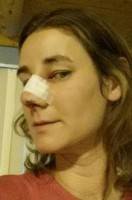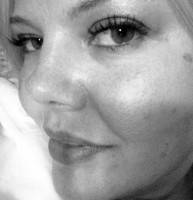Upturned nose after rhinoplasty
Early rhinoplasty results are difficult to assess. Give the nose a few weeks and then a better evaluation of how your rhinoplasty results are can be performed. (Anil R. Shah, MD, Chicago Facial Plastic Surgeon)
The initial swelling usually allows the tip to drop in a few weeks to a few months.
The tip swelling may last up to a year. Having said that, I don’t think your nose will drop enough to satisfy you, but I could be wrong.
Wait 3 months from the time of surgery and see a revision rhinoplasty surgeon who can show you good before/after photos of his revisions of shrt noses and speak with his patients. (Toby Mayer, MD, Beverly Hills Facial Plastic Surgeon)
This is a common concern after rhinoplasty. Yes, it is common for the nose to looked turned up the first several weeks following surgery.
Be patient, stay in touch with your surgeon, and give things time. (Mark Hamilton, MD, Indianapolis Facial Plastic Surgeon)
Upturned nose following rhinoplasty
The nasal tip typically takes about 1 year to settle following rhinoplasty. Size, shape and position will change during this period.
How exactly these change will depend own what was done during surgery and the way your body heals itself.
That being said, there is a tendency for the nasal tip to derotate (downturn) and deproject (the tip moves back towards the face) following rhinoplasty.
The degree to which both derotation and de-projection occur will depend largely on what was done technically during your surgery – that is how much structural support was added.
In your case, your surgeon may have overrotated the tip anticipating that it would derotate during your recovery to prevent your nose from having a tip that droops or hangs longterm. You should discuss your concerns with your surgeon. (Jamil Ahmad, MD, Toronto Plastic Surgeon)
Normally, the swelling of the nose after rhinoplasty can take up to three to four months to totally subside. It is possible that the tip itself could change during this time, leaving you with results you were hoping for. (John J. Edney, MD, Omaha Plastic Surgeon)
Expect some correction of your Rhinoplasty results with time
Many rhinoplasty patients request an improvement in tip rotation. Many surgeons will tape the nose and support the tip if tip rotation modifications were performed. This taping may exaggerate the tip rotation several days after surgery. Often, after swelling subsides, some degree of drop will occur. Be patient. You and your surgeon can follow how your nose heals and you will likely see the results you want after a few months. (Corey S. Maas, MD, San Francisco Facial Plastic Surgeon)
When will a nose tip that is too high drop?
Typically a surgeon will slightly overcorrect the tip position during rhinoplasty. In addition, there is immediate swelling, taping, and internal sutures that make the tip appear higher than it really is.
Once the swelling comes down, and the tissues relax, the tip should come down within as early as 2 to 3 weeks. In rare circumstances, you may see prolonged tip over-rotations. This may require a revision rhinoplasty. However, for now be patients and let the membranes, sutures etc. relax. (Ashkan Ghavami, MD, Beverly Hills Plastic Surgeon)
Nose Tip Upturned After Rhinoplasty
The nose can look too upturned during the recovery period and within a year for a variety of reasons especially if there is a fair amount of swelling in the lip area. It is for this reason that judging about the nose surgery outcome should be delayed until about a year after the surgery. (Bahman Guyuron, MD, Cleveland Plastic Surgeon)
Several days is way to early to evaluate a rhinoplasty result…
When the nose is taped after rhinoplasty it almost always looks higher than it really is. When a person lies down, the nose naturally lifts up some. When the tape is placed after surgery, the patient is usually lying down so the tip stays in its elevated position. When the tape comes off the rotation always decreases some, most of it occurring within two weeks. Additional changes can occur depending on what was done surgically and how the tip was supported. Be sure to discuss any concerns with your surgeon. (Andrew Miller, MD, Edison Facial Plastic Surgeon)


